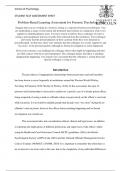School of Psychology
STUDENT SELF ASSESSMENT SHEET
Problem-Based Learning Assessment for Forensic Psychology MSc
Imagine that you are working in a forensic setting as a registered forensic psychologist. You
are undertaking a range of assessment and treatment interventions in conjunction with a very
supportive multidisciplinary team. You have reason to believe that a colleague of yours is
seeing a prisoner/patient who has recently been released from the institution. Your colleague
previously had the prisoner/patient on their caseload while they were detained in
prison/hospital. At that time, there were rumours that the colleague was overly supportive and
“too close” to the prisoner/patient, although no formal investigation or action happened.
Given your concerns, you challenge the colleague about what might be happening and their
possible contact with the ex-prisoner/patient. The colleague denies that there is anything
inappropriate happening. You remain very concerned that the colleague is seeing them and
that the colleague is lying to you.
Introduction
The prevalence of inappropriate relationships between prisoners and staff members
has been shown to occur frequently in institutions around the Western World (Worley,
Tewsbury & Frantzen, 2010; Worley & Worley, 2016). In this assessment, the topic of
prisoner-staff relationships is discussed in relation to a specific case of a female prison officer
being suspected of seeing a male ex-offender whom was previously on the officer’s case load
whilst in prison. It was noted by multiple people that the pair were “too close” during the ex-
offender’s time in prison, however the officer denies anything happening and no formal
investigation was carried out.
This assessment takes into consideration ethical, clinical and legal issues, in addition
to exploring the implications of different professions and supervisors of the officer; whilst
using the Health and Care Professions Council (HCPC) guidelines (2016), the British
Psychological Society’s (BPS) Code (2018) and the National Offender Management Service
Code of Conduct (NOMSCC) (NOMS, 2010). It is important to remember that often there is
no set answer to an issue such as this one, due to the complexity of any individual differences
, School of Psychology
STUDENT SELF ASSESSMENT SHEET
that may be present; however the Codes should be used as a guide for which professionals
can base their judgements around (BPS, 2018, section 4.1).
Ethical, Legal and Clinical Issues
When considering the ethical, legal and clinical boundaries surrounding inappropriate
relationships between current and ex-offenders and prison officers, there are a plethora of
issue that present themselves. While each of these set of issues have different definitions,
each is often found to be intertwined with another, creating a more complex issue altogether.
Researchers have often exclaimed that any form of “closeness” between a prison
officer and a prisoner is creating an unethical dual relationship (Llewelyn & Gardner, 2009;
Reamer, 2019). The Prison Rules 1999 agrees with this, stating that staff must not be in
contact with prisoners or ex-prisoners in or outside of their professional setting without
official authorisation. The primary concern regarding dual relationships between prisoners
and staff is that it is near impossible not to allow any personal views to affect professional
judgement, which is a key point in various professional codes of conduct (BPS, 2018, section
3.4(iv, v)HCPC, 2016, section 7.4). On the other hand, Hermann and Robinson-Kurpius
(2006) found dual relationships within the prison sector to be inescapable, due to existing on
a continuum with some relationships being potentially beneficial and others resulting in
negative outcomes.
In addition to this, Lazarus (1994) stated in his research that the permitting of risk
assessment and management to take priority over the act of humane intervention is an ethical
violation in itself. Therefore, it should also be considered that perhaps any potential boundary
violation between the prison officer and the ex-offender could have been a turning point for




